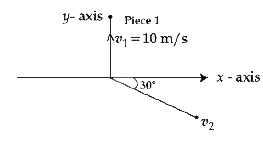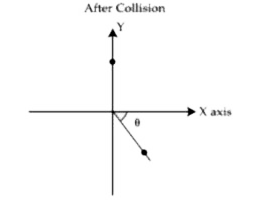A ball of mass 10 kg moving with a velocity 10√3m/s along the x-axis, hits another ball of mass 20 kg which is at rest. After the collision, first ball comes to rest while the second ball disintegrates into two equal pieces. One piece starts moving along y-axis with a speed of 10 m/s. The second piece starts moving at an angle of 30 with respect to the x-axis. The velocity of the ball moving at 30∘ with X-axis is x m/s. The configuration of pieces after collision is shown in the figure below.
The value of x to the nearest integer is ______

Step by step video & image solution for A ball of mass 10 kg moving with a velocity 10sqrt3 m//s along the x-axis, hits another ball of mass 20 kg which is at rest. After the collision, first ball comes to rest while the second ball disintegrates into two equal pieces. One piece starts moving along y-axis with a speed of 10 m/s. The second piece starts moving at an angle of 30 with respect to the x-axis. The velocity of the ball moving at 30^@ with X-axis is x m/s. The configuration of pieces after collision is shown in the figure below. The value of x to the nearest integer is ______ by Physics experts to help you in doubts & scoring excellent marks in Class 12 exams.
Updated on:21/07/2023Topper's Solved these Questions
Similar Questions
A ball of mass 10 kg moving with a velocity 10√3ms−1 along X-axis, hits another ball of mass 20 kg which is at rest. After collision, the first ball comes to rest and the second one disintegrates into two equal pieces. One of the pieces starts moving along Y-axis at a speed of 10 m/s. The second piece starts moving at a speed of 20 m/s at an angle θ (degree) with respect to the X-axis.
The configuration of pieces after collision is shown in the figure.
The value of θ to the nearest integer is_______

View SolutionA ball of maas m moving with a velocity v along X-axis, strikes another ball of mass 2m kept at rest. The first ball comes tor est after collision and the other breaks into two equal pieces. One of the pieces starts moving along Y-axis with a speed v1. what will be the velocity of the other piece?
View Solution
Knowledge Check
A ball of mass 5 kg travelling with velocity of 15 cm/s makes a head on collision with another ball of mass 1 kg which is at rest. After the collision, the speed of the lighter ball is
Azero.Bless than 15 cm/s.Cequal to 15 cm/s.Dgreater than 15 cm/s.A ball of mass 3 kg moving with a velocity of 3m/s collides with another ball of mass 1 kg moving with velocity u in the opposite direction. If the first ball comes to rest after the impact and e=2/7, then u is in m/s, is
A133B173C193D233A ball of mass 3 kg moving with a velocity of 3m/s collides with another ball of mass 1 kg moving with velocity u in the opposite direction. If the first ball comes to rest after the impact and e=2/7, then u is in m/s, is
A133B173C193D233
A ball of mass 100g moving at a speed of 12 m s−1 strikes another ball of mass 200 g at rest. After the collision both the balls move with a common velocity. Find the common velocity.
View SolutionA ball of mass 100g moving at a speed of 12 m s−1 strikes another ball of mass 200 g at rest. After the collision both the balls move with a common velocity. Find the common velocity.
View SolutionA ball of mass 100g moving at a speed of 12 m s−1 strikes another ball of mass 200 g at rest. After the collision both the balls stick to each other and move with a common velocity. Find the common velocity.
View SolutionA body of mass 5 kg moving with a velocity 10 m/s collides with another body of the mass 20 kg at, rest and comes to rest. The velocity of the second body due to collision is
View SolutionA body of mass 5 kg moving with a velocity 10 m/s collides with another body of the mass 20 kg at rest, and comes to rest. The velocity of the second body due to collision is
View Solution
